10 Fast-Growing Indoor Plants to Turn Your Interiors Into a Green Oasis
These plant babies grow up fast.
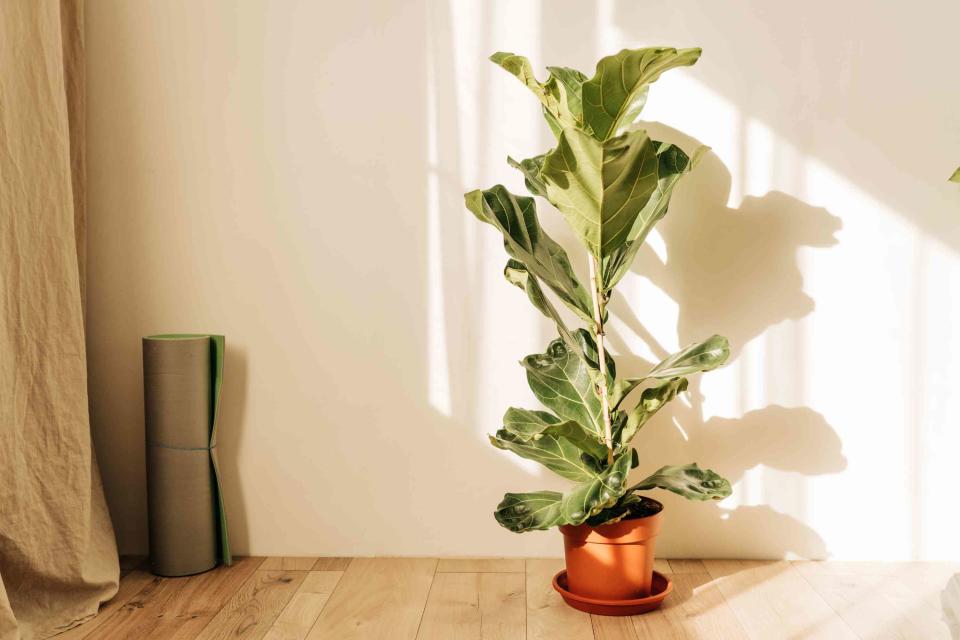
Kseniya Ovchinnikova/Getty Images
Are you drawn to nature and enjoy the serenity of being surrounded by gorgeous green plants? You can bring the outdoors inside and turn your home into a tranquil oasis by growing plants indoors. Having a variety of plants in your house is not only appealing to the eye, but also provides health benefits. In fact, research has shown that plants can reduce stress and boost your overall well-being.
Some plants can be slow as a snail to sprout, so rather than waiting forever for your favorite plant to mature, check out these fast-growing indoor plants to adorn your home with and create a serene space quickly.
Related: 20 Hard-to-Kill Indoor Plants That Don't Need Sunlight to Thrive
Fast-Growing Indoor Plants
These top ten indoor plants were hand-picked by the experts along with tips to care for each one. So, whether you want a tropical vibe or are searching for something a bit unique, we got you covered.
Aloe Vera
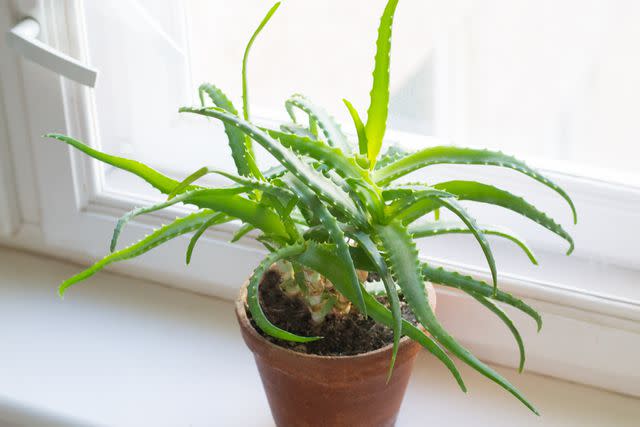
Albina Yalunina/Getty Images
Jane Dobbs, an expert gardener and gardening team lead at Allan's Gardeners, says aloe vera is one of the most popular succulent plants. It's known for its healing properties, and a soothing gel can be extracted from its fleshy leaves to treat skin problems. "The plant requires bright light and soil that drains well. Make sure you do not overwater it," she advises.
It's best to let the soil dry between waterings to prevent waterlogging. They also prefer warmer climates and thrive in temperatures between 65 and 75 degrees Fahrenheit. However, you want to avoid too much direct sunlight, as it can scorch their leaves. Aloe vera plants are typically low-maintenance plants, which makes them ideal for beginner growers.
Spider Plant
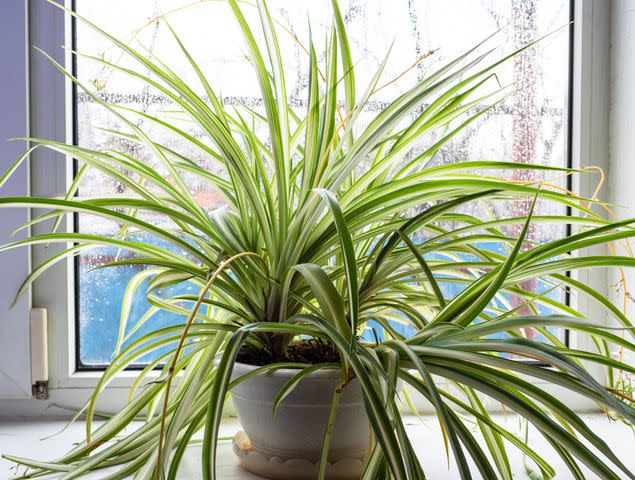
KrimKate/Getty Images
One of the most beloved and resilient houseplants to grow are spider plants. Nastya Vasylchyshyna, resident botany expert at Plantum, says these plants thrive in a light, loose, and pH-neutral potting mix that can be bought at any garden center.
As far as care goes spider plants require regular watering and plenty of light. "You should water regularly but avoid waterlogging. Give the plant a drink once the topsoil gets dry," she says.
She continues, "You can assess the soil moisture level by hand. You can also tell that your plant needs a drink by its appearance—it will start bending down when thirsty. However, make sure to check the soil as well. Keep in mind that overdrying of the growing medium will cause the leaves to dry."
"You need to provide your plant with enough bright but diffused light. Prolonged direct sunlight exposure can cause leaf scorch. The optimal place for a spider plant is on an east southwest, or west-facing windowsill. Unlike the variegated species, green-foliage ones can tolerate partial shade," she says.
She continues, "The optimal humidity for profound growth is about 60-65%. However, they can adapt to average indoor humidity as well."
Chinese Money Plant
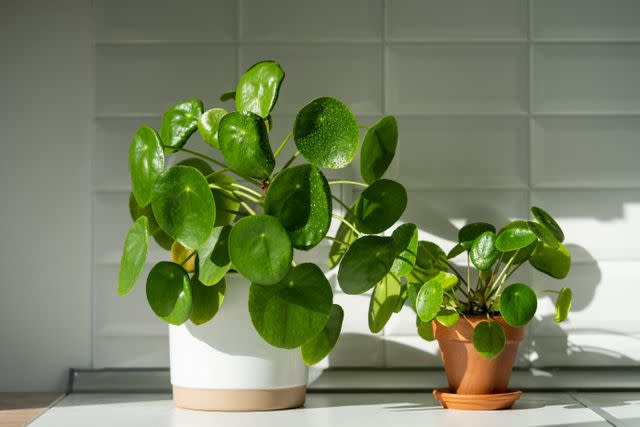
Dima Berlin/Getty images
If you're looking for a fast-growing plant that can add a quirky touch to the room, Dobbs suggests the Chinese money plant. This plant has round, pancake-shaped leaves and can grow between 8 and 12 inches tall. She says it can grow quickly in low and bright light, making it adaptable to a variety of indoor environments.
"I recommend bright, indirect light for this plant, and it needs to be watered when the soil feels dry to the touch," she informs. To keep this plant happy, you need to ensure the soil is rich and well-draining. They also need a stable climate and thrive in temperatures between 65 and 75 degrees Fahrenheit.
Spiderwort
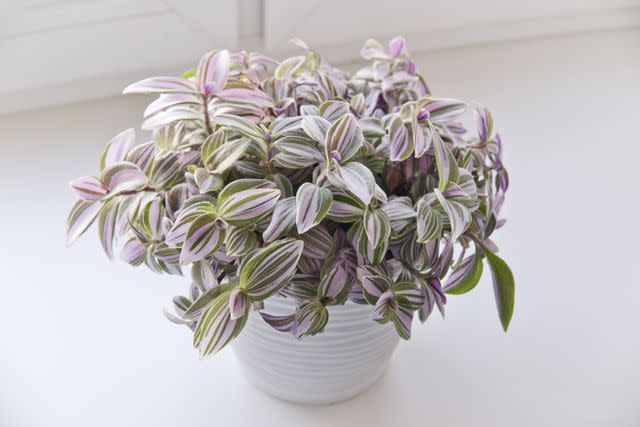
aryutkin photo/Getty images
Tradescantia, also known as spiderwort, is a fast-growing indoor plant that produces small, beautiful blooms in various colors, including purple, blue, pink, and white. Vasylchyshyna says this plant prefers constantly moist soil and tolerates neither overdrying nor waterlogging. "You should keep it at temperatures between 68 and 77 degrees Fahrenheit and water once every 3–4 days. However, you should tie the watering frequency to how long the soil takes to dry out," she explains.
She continues, "Variegated varieties need more sunlight than those with green foliage. Therefore, provide the plant with bright, diffused light and shield it from direct sunlight. The optimal place is next to a west or east-facing window."
She also says that if cared for properly, it can grow quickly and can be propagated by cuttings that root in water easily. You'll see the first roots 3–5 days after placing the shoots in water. In 2–3 weeks, they'll be completely ready for planting in soil.
"If you want your plant to grow as a lush bush, prune and repot it regularly. However, you can also hang the plant and let it grow long shoots. Timely remove dry and damaged leaves to keep the plant healthy and beautiful," she adds.
Monstera Deliciosa
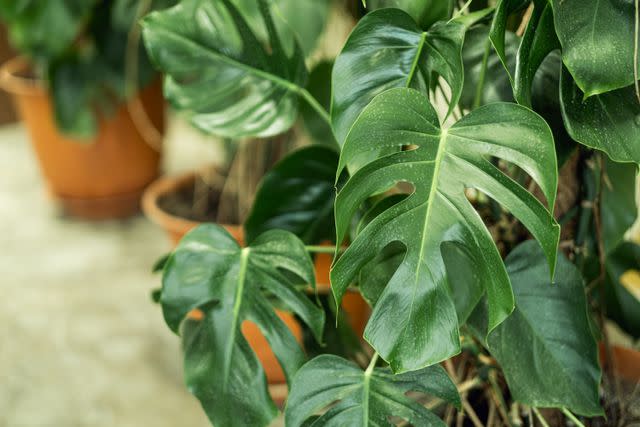
Elvira Kashapova/Getty Images
If you long for a rainforest feel in the comfort of your own home, then you should grow a monstera deliciosa plant. Dobbs says monstera can grow quite rapidly in the right conditions, often producing large, distinctive leaves with holes or splits. This is why they are also known as Swiss Cheese Plants. A healthy Monstera Deliciosa can grow 10 to 15 feet tall.
"They prefer bright, indirect light and well-draining soil. When the top inch of the soil is dry, it is time to water it," she advises. This plant also loves humid environments and thrives in temperatures above 60 degrees Fahrenheit.
Due to their coarse roots, monstera needs well-drained organic soil to allow air around their roots and prevent damage. There are actually 50 different species of Monstera, so refer to the care label to ensure you create the right indoor environment for it to flourish.
Dieffenbachia (Dumb Cane)
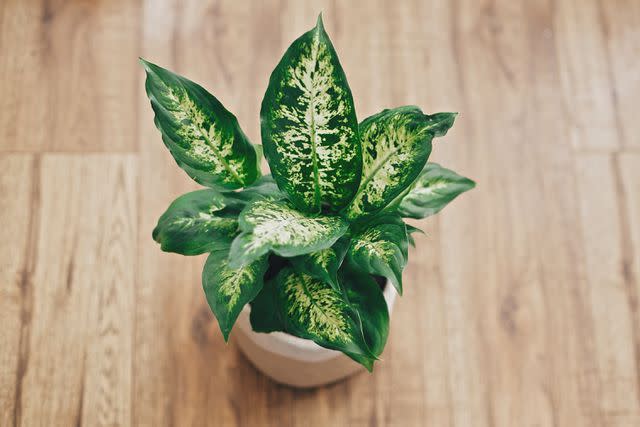
Bogdan Kurylo/Getty Images
The Dieffenbachia plant is another amazing, fast-growing indoor plant that will give your home a tropical vibe. There are a few Dieffenbachia varieties to choose from too. "Dieffenbachia thrive in high humidity, so mist them using a fine mist sprayer filled with warm water. The most efficient way to increase indoor humidity is to use a humidifier, Vasylchyshyna advises.
She continues, "During the period of active growth, give your plant a warm shower once a month. Wipe the dust off its leaves with a soft sponge and then rinse them with warm water that's about 77-86 degrees Fahrenheit. Cover the surface of the soil with plastic wrap to avoid waterlogging. If you can't give the plant a warm shower, wipe the dust off the leaves with a paper towel or sponge."
You should provide this plant with bright, filtered light. "However, prolonged exposure to the bright afternoon sun can burn the leaves. The optimal place is next to a west or east-facing window or 7–10 feet away from a south-facing one," she says.
You should protect the plants from drastic temperature changes or cold drafts and be sure to keep them at temperatures higher than 64–66 degrees Fahrenheit.
Snake Plant
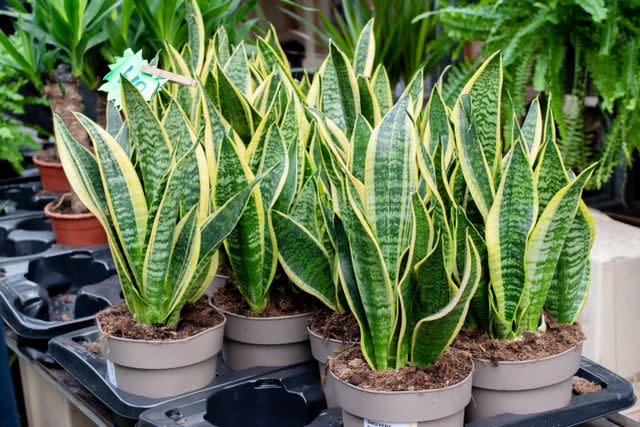
Grumpy Cow Studios/Getty Images
"Known for their upright, sword-like leaves, snake plants, or Sansevieria, are among the most popular plants in the world," says Dobbs. "As well as growing rapidly, they purify the air, adapt well to a wide range of light conditions and do not require much watering."
Similar to succulents, it can be easy to overwater a snake plant because they are drought-tolerant. Typically, you can water about once a week, but you should feel the soil to see if it's dry to see if it is time to water. Although these plants can tolerate various lighting conditions, they tend to do best in indirect light settings.
They thrive when temperatures range between 65 and 75 degrees Fahrenheit, and since they are tropical plants, they also grow faster in humid climates. They are a perfect plant for the bedroom because of their air-purifying qualities and adaptability to various light conditions.
Heartleaf Philodendron
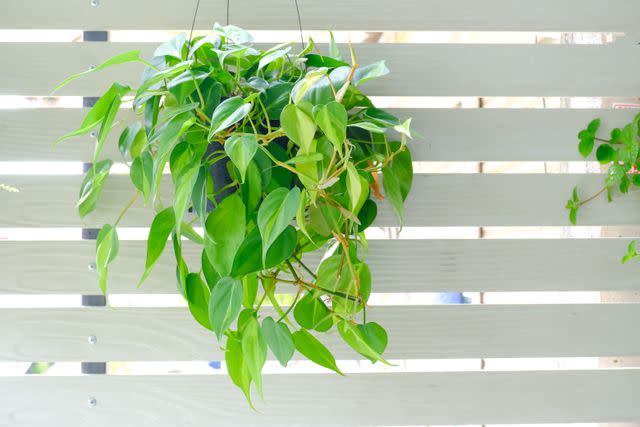
M.photostock/Getty Images
The heartleaf philodendron is one of the easiest and most adaptable indoor plants to grow. "Trailing vines and heart-shaped leaves are two of philodendron's most distinctive features. They are fast-growing and adaptable to a variety of conditions," says Dobbs. "This plant thrives in indirect light and requires regular watering."
You will need to water this plant every week or two to keep it healthy. However, you want to allow the soil to dry out to prevent root rot. It requires moist, well-draining soil, and you can ensure proper drainage by adding some perlite to the soil.
As far as humidity is concerned, it's the goldilocks of plants because they like the right amount of humidity. It can tolerate dry air more than other plants, but too much humidity can cause the leaves to get fungus. Ideal temperatures range between 65 and 85 degrees Fahrenheit. However, this plant is resilient which is why it's an excellent choice for your indoor oasis.
Fiddle Leaf Fig
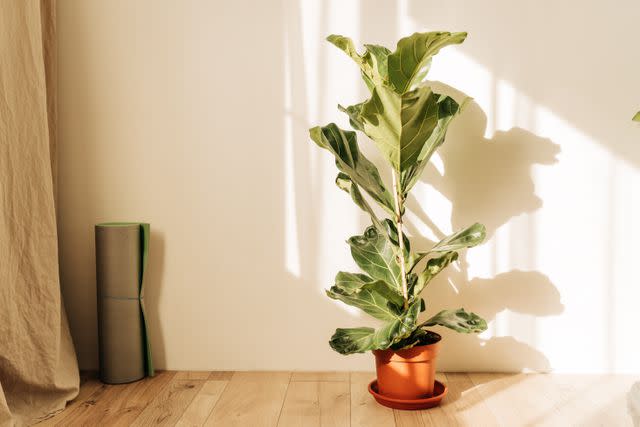
Kseniya Ovchinnikova/Getty Images
A fiddle-leaf fig is a fantastic indoor plant that will glam up your interiors with its bright green glossy leaves. They can grow up to ten feet tall indoors, so make sure you have plenty of space for this beauty. "Under the right conditions, they grow fast and are a great focal point for any room," says Dobbs.
She continues, "The plant requires bright, indirect light and consistent moisture." Typically, you will need to water it every 7 to 10 days, but you should allow the soil to be at least 50% dry before watering. The soil needs to be slightly acidic but rich in organic matter. The best temperatures for fiddle leaf figs are between 60 to 80 degrees Fahrenheit and moderate humidity. This plant can be a bit finicky regarding care, so keep that in mind if you are a beginner gardener.
Pothos Plant
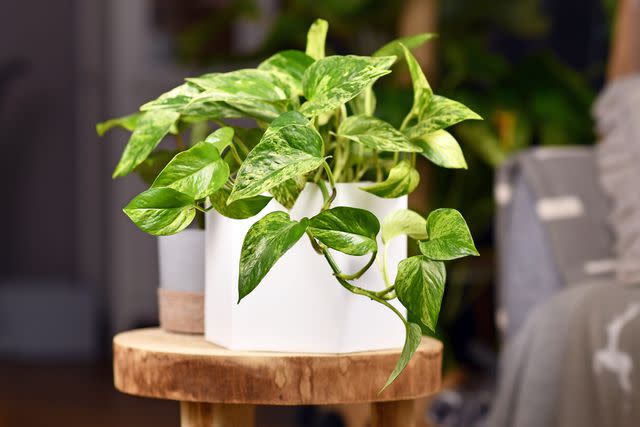
Firn/Getty Images
One of Dobbs top picks is the pothos plant. She says that it is a low-maintenance plant and thrives in low light. "Trailing vines can grow several feet long, making it ideal for vertical spaces. Plants need minimal care, tolerate low light, and must be watered when the soil is dry on the top.
Vasylchyshyna says that the pothos plant, aka Epipremnum, is similar to the Dieffenbachia because they belong to the Araceae family and have similar care requirements. It flourishes in bright filtered light and temperatures above 64 degrees Fahrenheit.
"They need fertile, loose, light, and well-draining soil. The substrate should contain peat, loam-based and leaf mold compost, and sand or perlite," she advises. It also loves high humidity, so you will want to mist with warm water or utilize a humidifier.
She warns to avoid overwatering and not to allow excess water to accumulate at the bottom of the pot to prevent root rot. "These plants don't tolerate overdrying of the substrate as well, so make sure to give them a drink when the topsoil dries by about half an inch," she informs.
"The water amount should equal about ¼–⅓ of the volume of the container. Let excess water drain out of the holes and empty the saucer 5–10 minutes after watering."
Things to Consider When Choosing Fast-Growing Indoor Plants
Before you take off to the local garden center there are some things to consider and be aware of so you can pick the perfect plants for your home and living situation.
Certain Plants Can be Toxic to Pets. Many indoor plants, such as Dieffenbachia (Dumb Cane) and Philodendron, are poisonous to pets. Toxic plants can cause severe health problems or even death, so always research plants before putting them in your home.Some plants can even be toxic to people if ingested, so if you have children you should keep that in mind too.
Plant Size and Space: You should consider the amount of space you have for the size of the plant you want to grow to ensure it is a good fit for the area you plan on putting it in. For instance, Monstera plants can get up to 15 feet tall, and heartleaf philodendrons are trailing plants that require room to expand. So, size up your space to help determine which plant is best for the room you have to work with.
Plant Care: Consider how much time you can dedicate to nurturing your new plants and how much care they require. Some plants need more attention than others, such as the fiddle leaf fig, which can be picky about its climate. If you are a beginner plant parent, then opt for a low-maintenance plant like a spider plant.
Climate: When picking plants, you want to make sure you can provide the proper climate for them to thrive. So, if your plant requires high humidity, consider making space in your bathroom for it to live as long as there is enough light as well. Check the care tags to ensure you can create the environment the plant needs to flourish.
Decorating with indoor plants can create a relaxing ambiance that will make your home lush and have a positive effect on your mood.
For more Real Simple news, make sure to sign up for our newsletter!
Read the original article on Real Simple.


